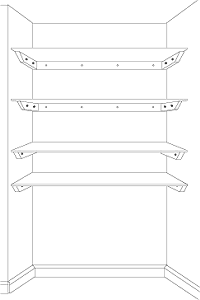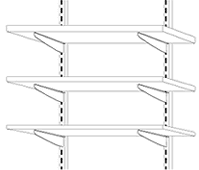Shelving - the different types
Shelving is always useful around any home for added storage space, whether it's a shelf in the bathroom, kitchen, garage or workshop. There are various options of shelving to suit different uses, wall construction with various types of shelf material.
When considering which type of shelf mounting to use and the type of shelf material, what will be placed on them and the look of the shelving may need to be considered.
What you place on the shelves will influence how strong they need to be, this will have an effect upon the material used for the shelving itself, the distance between supports and the method of supporting the shelving.
The shelving styles discussed in this article are:
- Built in shelving - a useful way to use an alcove (often found both sides of a chimney breast). The actual alcove effectively provide two vertical ends and supports for the shelves are fixed to the sides of the alcove.
- Fixed brackets - probably the most common arrangement - brackets are fixed to the vertical wall and the shelving is placed across them.
- Adjustable Shelving Systems - custom made for the job, these usually use vertical rails with adjustable height brackets to achieve different shelf spacings - these are useful but may be costly.
The method chosen to secure the shelving to the wall, will be influenced by the type of wall in question; walls may be masonry covered in plaster, masonry dry lined with plasterboard or plasterboard or lathe and plaster studding. Each type of wall will require a different approach to fixing the shelving, these are explained on our page for how to make strong fixings.
Shelving faults
It is a good idea to consider the faults commonly associated with shelving, this will give you an idea of what not to do.
No matter which style of shelving is used, their failures tend to be because of one of the followings:
- The fixings pull out of the wall - this may be the result of:
- The screws being too short,
- The wrong type of wall plugs being used or the correct type not being used correctly. As mentioned previously, see our page on how to make strong fixings to different types of wall.
- The brackets bending - the brackets need to be strong enough to support the weight being put on the shelf.
- The shelf 'sagging' - for a given type/thickness of shelving material, this is usually the result of the supports being too widely spaced: or looked at another way, the wrong type/thickness of shelf material being used for the spacings of the support.
- Shelving material breaking (usually follows sever sagging) - the causes are the same as for the shelf sagging (above), just gone to the extreme.
Individual brackets.
 Using a number of individual brackets fixed to a vertical surface (i.e. wall) with the shelf material laid across the top of them is probably the most widely form of shelving used.
Using a number of individual brackets fixed to a vertical surface (i.e. wall) with the shelf material laid across the top of them is probably the most widely form of shelving used.
There is a wide range of shapes and sizes of individual shelf brackets available - something will suit any requirements. Brackets range from the simple, plain brackets to highly decorative ones with a huge variety in between. There are also a wide range of sizes, colours and finishes.
The lengths of the two arms which make up the 'L' shape of brackets tend to be of different lengths. The longer arm normally fits against the wall, while the shelf material is laid across the shorter arm which projects from the wall - this reduces the lever effect which the bracket has on the wall fixings. The width of the shelf material used should only project slightly further forward from the wall than the shorter arm of the bracket itself.
Brackets can be fixed directly onto the face of masonry and masonry/plaster walls just using the appropriate wall plugs and screws. Alternatively a wooden batten can first be fixed vertical to the wall at each bracket position and then the brackets screwed to the battens.
For detailed advice for fitting shelves using brackets, see our other articles:
- Short shelves - when it's easier to fix the brackets to the shelf before fixing the brackets to a wall.
- Long shelves - where the brackets are first fixed to the wall, and then the shelf material laid across them.
Built in shelving
 Using an existing alcove where the shelf supports can be fixed at the sides is one of the easiest/quickest ways to put up shelving and often uses a space which would otherwise be wasted.
Using an existing alcove where the shelf supports can be fixed at the sides is one of the easiest/quickest ways to put up shelving and often uses a space which would otherwise be wasted.
Although the length of the shelving is effectively determined by the size of alcove, these types of shelves can be quite flexible:
- They can be arranged to provide shelving with different heights and depths, the shelves don't all need to be the same.
- The height of the lowest shelf can be arranged to leave space underneath for a piece of furniture standing on the floor.
For detailed advice for fitting shelves into an alcove, see our other article: fitting shelving in an alcove.
Adjustable Shelving Systems
 Adjustable shelving systems are readily available - to put them up, just fix the vertical rails to a wall and then slot in the brackets to support the shelves.
Adjustable shelving systems are readily available - to put them up, just fix the vertical rails to a wall and then slot in the brackets to support the shelves.
The systems generally consists of two main parts:
- The vertical rails which are secured to the wall.
- The shelf brackets which just slot or clip into the vertical rails and support the shelving material.
Note that the parts from different manufacturers or systems are not usually interchangeable - so problems may be encountered if the system needs to be extended in the future and the original range/manufacturer cannot be identified or located.
The rails and brackets are usually made from either aluminium or steel and come in various sizes - the rails to suit the height, and the brackets to suit the width of shelving used.
These manufactured systems are a simple method of shelving that is easy and quick to fix in place and which provide robust, neat and easy to adjust shelving - but at a price..
